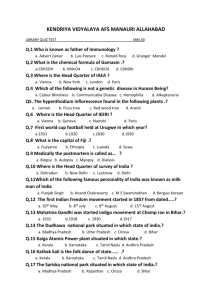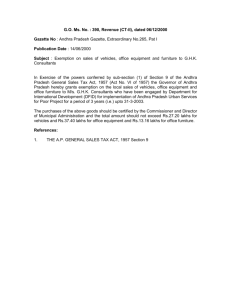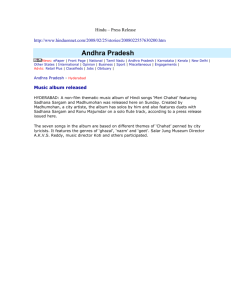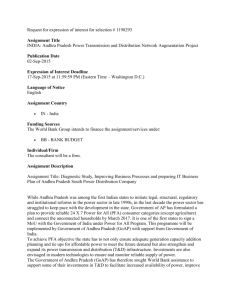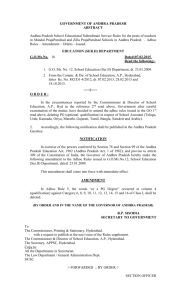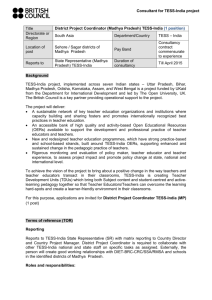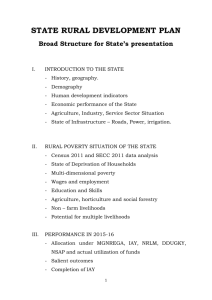Policy Implementation and Impact Review: A Case of MGNREGA in... Arsalan Ali Farooquee Mediterranean Journal of Social Sciences
advertisement
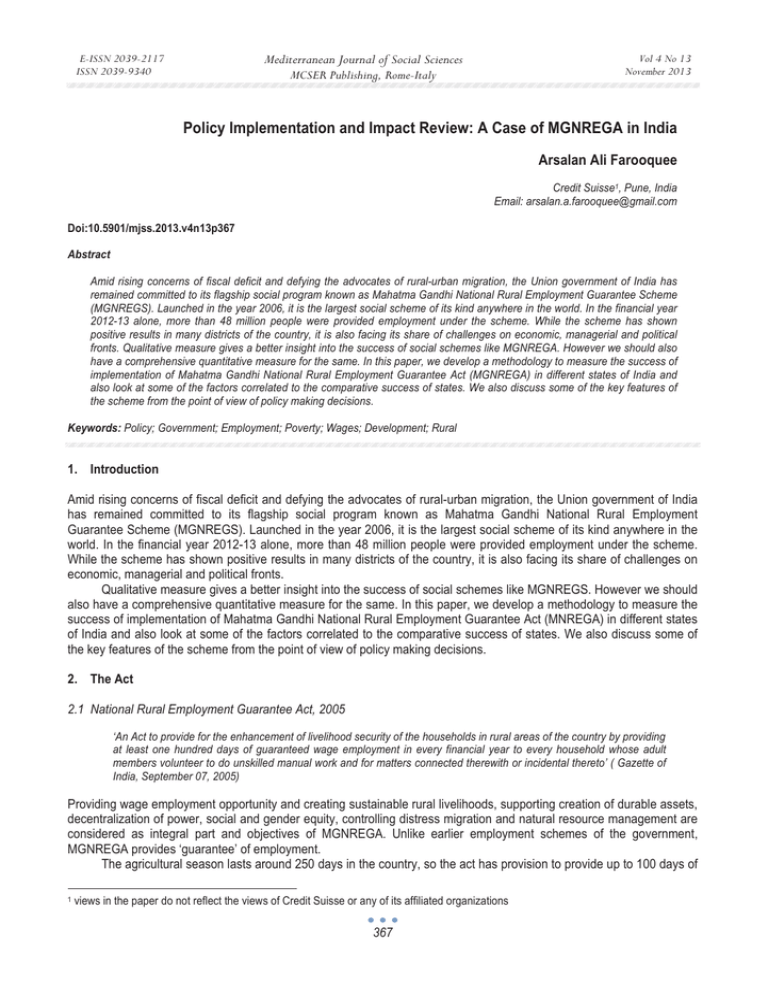
Mediterranean Journal of Social Sciences E-ISSN 2039-2117 ISSN 2039-9340 Vol 4 No 13 November 2013 MCSER Publishing, Rome-Italy Policy Implementation and Impact Review: A Case of MGNREGA in India Arsalan Ali Farooquee Credit Suisse1, Pune, India Email: arsalan.a.farooquee@gmail.com Doi:10.5901/mjss.2013.v4n13p367 Abstract Amid rising concerns of fiscal deficit and defying the advocates of rural-urban migration, the Union government of India has remained committed to its flagship social program known as Mahatma Gandhi National Rural Employment Guarantee Scheme (MGNREGS). Launched in the year 2006, it is the largest social scheme of its kind anywhere in the world. In the financial year 2012-13 alone, more than 48 million people were provided employment under the scheme. While the scheme has shown positive results in many districts of the country, it is also facing its share of challenges on economic, managerial and political fronts. Qualitative measure gives a better insight into the success of social schemes like MGNREGA. However we should also have a comprehensive quantitative measure for the same. In this paper, we develop a methodology to measure the success of implementation of Mahatma Gandhi National Rural Employment Guarantee Act (MGNREGA) in different states of India and also look at some of the factors correlated to the comparative success of states. We also discuss some of the key features of the scheme from the point of view of policy making decisions. Keywords: Policy; Government; Employment; Poverty; Wages; Development; Rural 1. Introduction Amid rising concerns of fiscal deficit and defying the advocates of rural-urban migration, the Union government of India has remained committed to its flagship social program known as Mahatma Gandhi National Rural Employment Guarantee Scheme (MGNREGS). Launched in the year 2006, it is the largest social scheme of its kind anywhere in the world. In the financial year 2012-13 alone, more than 48 million people were provided employment under the scheme. While the scheme has shown positive results in many districts of the country, it is also facing its share of challenges on economic, managerial and political fronts. Qualitative measure gives a better insight into the success of social schemes like MGNREGS. However we should also have a comprehensive quantitative measure for the same. In this paper, we develop a methodology to measure the success of implementation of Mahatma Gandhi National Rural Employment Guarantee Act (MNREGA) in different states of India and also look at some of the factors correlated to the comparative success of states. We also discuss some of the key features of the scheme from the point of view of policy making decisions. 2. The Act 2.1 National Rural Employment Guarantee Act, 2005 ‘An Act to provide for the enhancement of livelihood security of the households in rural areas of the country by providing at least one hundred days of guaranteed wage employment in every financial year to every household whose adult members volunteer to do unskilled manual work and for matters connected therewith or incidental thereto’ ( Gazette of India, September 07, 2005) Providing wage employment opportunity and creating sustainable rural livelihoods, supporting creation of durable assets, decentralization of power, social and gender equity, controlling distress migration and natural resource management are considered as integral part and objectives of MGNREGA. Unlike earlier employment schemes of the government, MGNREGA provides ‘guarantee’ of employment. The agricultural season lasts around 250 days in the country, so the act has provision to provide up to 100 days of 1 views in the paper do not reflect the views of Credit Suisse or any of its affiliated organizations 367 E-ISSN 2039-2117 ISSN 2039-9340 Mediterranean Journal of Social Sciences MCSER Publishing, Rome-Italy Vol 4 No 13 November 2013 unskilled manual labor work on demand. The Act covered 200 districts in its first phase, launched on February 2, 2006, and was extended to 130 additional districts in the year 2007-2008. The scheme was extended to all the rural areas in India from April 1, 2008. As per the act, State governments are responsible for providing the work under the scheme. Central government provides 100% funding for the wages for unskilled manual work and 75% of material cost which includes payment to semi-skilled and skilled workers. Rest is borne by the state government. Employment must be provided within 15 days of application, failing which unemployment allowance is paid to the person demanding the work. 100% cost of unemployment allowance is on state government. Wage payments are made through bank accounts or post office savings account, leading to greater transparency. Use of machinery or contractors on MGNREGA work sites is not allowed. The work must be provided within 5km of the residence of the household demanding work; else travelling allowance is paid separately. The act also has provision for the minimum wages to be paid. Further, at least one-third of the beneficiaries of MGNREGA should be women. Employment is provided only to the job card holders. Few studies (The Economic Times report, March 15 2009) have criticized MGNREGA on the grounds that it discourages labor mobility and argue that migration. However, from the point of view of policy decision, the key features of MGNREGA reveal that it is meant to tackle underemployment as it guarantees employment up to 100 days only. Further, this 100 days bracket is meant to ensure that the scheme does not hamper availability of labor for agricultural sector in India. Further the popular theories on migration, like The Todaro model of migration (Harris, John R. & Todaro, Michael P., 1970) or the Dual sector model (W.A Lewis) reveal that rural-urban migration is because of the disequilibrium in the society. In a country with socio-economic condition like India, it is imperative for the Government to focus on curbing distress migration and focus on creating employment opportunities in the rural areas. 3. A look at Country Level Data for MGNREGS (Financial Year 2008-09 to 2012-13) The data has been taken from DMU report available at official website of NREGA (http://nrega.nic.in/netnrega /home.aspx). Figure I: Total expenditure on MGNREGS Figure II: Total number of housholds provided employement 368 E-ISSN 2039-2117 ISSN 2039-9340 Mediterranean Journal of Social Sciences MCSER Publishing, Rome-Italy Vol 4 No 13 November 2013 Figure III: percentage of women participation 4. Methodology to Measure the Comparative Success of Implementation of MGNREGA The success of social schemes like MGNREGA is better gauged qualitatively. However, we should also have a quantitative measure for its success. A study titled MGNREGA Implementation: A Cross-State Comparison(2012* discusses a measure of implementation success of MGNREGA taking ‘Average Person-Days Worked per Rural Household’, ‘wage levels’ and ‘women inclusion’ as success indicators. The above mentioned paper does not take into account the quality of assets being created through MGNREGA in the measure of success of implementation. Also, taking figures for the average person days worked per rural household in absolute terms has limitations and this variable parameter if adjusted will yield better results. For example, in the financial year 2012-13, average person days of work provided per household in Jharkhand and Uttrakhand was 39.5 and 39.96 respectively. It is important to note that although the two numbers are similar in absolute terms but they reflect different degrees of success/failure of the states to provide employment. The quality of assets being created to boost the rural infrastructure has been a key concern in the implementation of this program and also a major cause of criticism. There is a ban on the use of machinery and contractors at the MGNREGA work sites and most of the work is done using shovels. The goal is to generate as much employment as required. In this section, we will develop a methodology to measure the success of MGNREGA in quantitative terms. Any measure of the success of this social scheme must relate to its objectives. Creating wage employment opportunities and sustainable rural livelihood, creation of durable assets in rural areas, decentralization of power, social and gender equity, natural resource management and controlling distress migration are considered integral part of this program. We will use the parameters below to develop a quantitative measure of the implementation success of MGNREGA. The data for analysis in this section has been taken from DMU report available at official website of NREGA (http://nrega.nic.in/netnrega/home.aspx). 1. Ratio of number of households provided employment to the number of households who demanded employment. 2. Average person days of work provided per household. However, we will not use absolute numbers directly but rather develop a relative percentile which also captures the demand of work to some extent. MGNREGA is demand based. It may have happened that people didn’t demand employment under the act for the full 100 days. A study by UNDP(www.business-standard.com ; 2013) showed that 42% households that sought employment under MGNREGA and on whose land work was undertaken, did not come back to work on MGNREGA, implying that they improved materially and did not need it anymore. Hence the deviation of average person days of work provided from 100 reflects different levels of success/failure of the states to provide employment. It is expected and also assumed that in the states with greater rate of poverty, greater percentage of people provided employment under the scheme would be willing to work for 100 days. For example, consider the scenario below of two states. States Jharkhand Uttrakhand % of rural population below poverty line(2009-10; Tendulkar’s methodology) 41.6 14.9 369 Average person days of work provided per household under MGNREGA(2012-13) 39.5 39.96 E-ISSN 2039-2117 ISSN 2039-9340 Mediterranean Journal of Social Sciences MCSER Publishing, Rome-Italy Vol 4 No 13 November 2013 Considering poverty rate, this method partially captures both the supply side i.e. ability of a state to provide full 100 days of employment under MGNREGA and also demand side of the work. So, Uttrakhand outperforms Jharkhand, by the parameter of average person days of work provided per household although the absolute number of person days is similar for both the sates. For details of derivation, please refer to Appendix. 3. Percentage of women participation: This captures the success of the scheme in terms of gender equity. 4. Expenditure on wages per household employed. 5. The quality of assets created. This is difficult to measure based on secondary data available. The type of works undertaken varies from water conservation, flood control, drought proofing to micro irrigation works, land development, fisheries and construction of roads. Since the use of machinery and contractors is not allowed at MGNREGA work sites and the shelf of projects is generally made for one year, quality of assets can be measured to some extent by the total person days deployed per work taken up. This measure of the quality of assets created neglects the productivity of workers. It has other limitations also. However, it can be used as a variable in measuring the overall success of MGNREGA. For the purpose of this study, we have considered top 25 states of India based on the number of people provided employment under MGNREGA. Using the cumulative score based on all the five parameters listed above, we get the ranking of the states as shown in Table I for the financial year 2012-2013. For details of the method used, please refer to Appendix. Table I: Ranks of states based on the comparative success of implementation of MGNREGA Rank 1 2 3 4 5 6 7 7 9 10 11 12 13 14 15 16 17 18 19 20 20 22 23 24 25 States Tripura Tamil Nadu Meghalaya Mizoram Nagaland Andhra Pradesh Himachal Pradesh Rajasthan Uttarakhand Haryana Kerala Manipur Punjab Chhattisgarh Madhya Pradesh Karnataka Gujarat West Bengal Jharkhand Bihar Maharashtra Jammu And Kashmir Assam Odisha Uttar Pradesh As a matter of perception in India, Rajasthan, Andhra Pradesh and Tamil Nadu are the states considered to have implemented MGNREGA well, while Uttar Pradesh, Bihar and Orissa are known to have struggled. Such perceptions however are not backed by a single comprehensive measure of success or any quantitative measurement tool. The methodology used in this paper to measure the implementation success of MGNREGA gives expected results of the performance rankings of states. 370 Mediterranean Journal of Social Sciences E-ISSN 2039-2117 ISSN 2039-9340 Vol 4 No 13 November 2013 MCSER Publishing, Rome-Italy 4.1 Spearman's rank correlation coefficient States Andhra Pradesh Assam Bihar Chhattisgarh Gujarat Haryana Himachal Pradesh Jammu and Kashmir Jharkhand Karnataka Kerala Madhya Pradesh Maharashtra Manipur Meghalaya Mizoram Nagaland Odisha Punjab Rajasthan Tamil Nadu Tripura Uttar Pradesh Uttarakhand West Bengal Poverty rank(R2), MGNREGA Performance Rank (R1) (derived from Table II) 6 11 23 20 20 24 14 25 17 14 10 7 7.5 2 d=(R2R1) 5 -3 4 11 -3 -3 -5.5 25 9 16 121 9 9 30.25 d2 Literacy d= R3rank(R3) R1 22 16 17 -6 25 5 18 4 10 -7 13 3 4 -3.5 22 1 -21 441 21 19 16 11 15 20 12 3 4 5 24 13 7.5 2 1 25 9 18 21 12 3 22 16 23 6 17 8 18 4 13 10 9 19 5 15 2 -4 -8 7 -4 11 3 13 3 -6 -9 5.5 8 8 -6 -4 -3 sum of d2 n n3 n3-n r 4 16 64 49 16 121 9 169 9 36 81 30.25 64 64 36 16 9 23 14 1 19 5 8 15 2 7 16 12 24 6 3 20 9 11 1453.5 25 15625 15600 0.4409615 -1 d2 256 36 25 16 49 9 12.25 1 4 16 -2 4 -10 100 4 16 -15 225 -4 16 12 144 -2 4 2 4 -8 64 -1 1 16.5 272.25 4 16 2 4 -5 25 0 0 -7 49 sum of 1364.5 d2 n 25 n3 15625 n3-n 15600 r 0.4751923 The above correlation(r) is found to be significant at 5% level (i.e. there is more than 95% chance that the relationship is significant and not random). Hence there’s a positive correlation between MGNREGA performance of a state and its poverty ranks and literacy levels. 5. Conclusion Amid rising concerns of fiscal deficit and defying the advocates of rural-urban migration, the Union government of India has remained committed to its flagship social program known as Mahatma Gandhi National Rural Employment Guarantee Scheme (MGNREGS). Launched in the year 2006, it is the largest social scheme of its kind anywhere in the world. In the financial year 2012-13 alone, more than 48 million people were provided employment under the scheme. While the scheme has shown positive results in many districts of the country, it is also facing its share of challenges on economic, managerial and political fronts. In this paper, we developed a methodology to measure the success of MGNREGA in quantitative terms using the five parameters, namely, Ratio of number of households provided employment to the number of households who demanded employment, Average person days of work provided per household, Percentage of women participation, Expenditure on wages per household employed, and the quality of assets created under the scheme. As a matter of perception in India, Rajasthan, Andhra Pradesh and Tamil Nadu are the states considered to have implemented MGNREGA well, while Uttar Pradesh, Bihar and Orissa are known to have struggled. The methodology 371 E-ISSN 2039-2117 ISSN 2039-9340 Mediterranean Journal of Social Sciences MCSER Publishing, Rome-Italy Vol 4 No 13 November 2013 used in this paper to measure the implementation success of MGNREGA gives expected results of the performance rankings of states. Also, a positive correlation was found between MGNREGA performance of a state and its poverty ranks and literacy levels. This correlation links the success of implementation of social schemes like MGNREGA with the capacity of the states as the poverty levels are indicative of the ability of the government in the area of policy making and implementation. The correlation also reveals that greater literacy levels are positively correlated with MGNREGA performance of state. Greater literacy levels lead to greater awareness levels and hence more rural people of such states are expected to exercise their right to work as enshrined in the act. References Harris, John R. & Todaro, Michael P. (1970), "Migration, Unemployment and Development: A Two-Sector Analysis", American Economic Review W.A Lewis., 1954, "Economic Development with Unlimited Supplies of Labor" “MGNREGA Implementation: A Cross-State Comparison(2012)”; Kim Bonner, Jennifer Daum, Jessie Duncan, Ellen Dinsmore, Kari Fuglesten,Leslie Lai, Julian Lee, Katherine Manchester, Feker Tadesse, Robert Quinn; Woodrow Wilson School, Princeton University “Many using MGNREGS labour for their land shifting to horticulture”., May 18, 2013., (www.business-standard.com/article/printerfriendly- version?article_id=113051500904_1) Appendix Table II: Ranking of states based on average person days of work provided per household States Andhra Pradesh Assam Bihar Chhattisgarh Gujarat Haryana Himachal Pradesh Jammu And Kashmir Jharkhand Karnataka Kerala Madhya Pradesh Maharashtra Manipur Meghalaya Mizoram Nagaland Odisha Punjab Rajasthan Tamil Nadu Tripura Uttar Pradesh Uttarakhand West Bengal % of rural population below poverty line (Tendulkar's methodology,2009-10) 22.8 39.9 55.3 56.1 26.7 18.6 9.1 8.1 41.6 26.1 12 42 29.5 47.4 15.3 31.1 19.3 39.2 14.6 26.4 21.2 19.8 39.4 14.9 28.8 Average persondays of work provided per household(P2) 49.61 25.44 43.32 45.04 41.31 43.57 48.67 48.93 39.5 46.48 54.83 36.1 52.66 37.13 44.77 73.24 35.1 34.11 27.08 51.9 57.82 86.78 28.2 39.96 33.66 372 Score to be used for ranking parameter P2 2.175877193 0.637593985 0.783363472 0.80285205 1.547191011 2.342473118 5.348351648 6.040740741 0.949519231 1.780842912 4.569166667 0.85952381 1.785084746 0.783333333 2.926143791 2.354983923 1.81865285 0.870153061 1.854794521 1.965909091 2.727358491 4.382828283 0.715736041 2.681879195 1.16875 Rank of states based on P2 Percentile score alone 10 62.50% 25 0.00% 22 12.50% 21 16.60% 16 37.50% 9 66.60% 2 95.80% 1 100.00% 18 29.10% 15 41.60% 3 91.60% 20 20.80% 14 45.80% 23 8.30% 5 83.30% 8 70.80% 13 50.00% 19 25.00% 12 54.10% 11 58.30% 6 79.10% 4 87.50% 24 4.10% 7 75.00% 17 33.30% Mediterranean Journal of Social Sciences E-ISSN 2039-2117 ISSN 2039-9340 Vol 4 No 13 November 2013 MCSER Publishing, Rome-Italy Table III: Ranking of states based on average wages per household States Andhra Pradesh Assam Bihar Chhattisgarh Gujarat Haryana Himachal Pradesh Jammu and Kashmir Jharkhand Karnataka Kerala Madhya Pradesh Maharashtra Manipur Meghalaya Mizoram Nagaland Odisha Punjab Rajasthan Tamil Nadu Tripura Uttar Pradesh Uttarakhand West Bengal No. of households Expenditure on Wages per household Rank based on Percentile provided employment Wages (Rs. In lakhs) (Rs. In lakhs) ;P4 parameter P4 alone 5506369 335056.21 0.060848848 12 54.10% 1217074 50385.2 0.041398633 22 12.50% 1908553 162216.38 0.084994433 4 87.50% 2626054 115934.25 0.044147702 19 25.00% 678040 47886.09 0.070624285 6 79.10% 290849 14225.69 0.048910913 17 33.30% 491848 27769.08 0.056458662 15 41.60% 492191 23727.39 0.048207688 18 29.10% 1394426 85807.14 0.061535815 11 58.30% 1337882 157562.9 0.117770401 1 100.00% 1525486 63676.86 0.041742015 20 20.80% 3080587 214931.93 0.069769797 7 75.00% 1548667 26886.88 0.017361305 25 0.00% 427856 27477.17 0.064220602 10 62.50% 300297 19925.71 0.066353344 8 70.80% 173967 19239.94 0.110595343 2 95.80% 375740 34396.65 0.091543754 3 91.60% 1598097 93293.05 0.058377589 14 45.80% 234838 9765.26 0.041582964 21 16.60% 4201386 227202.51 0.05407799 16 37.50% 7054997 221453.08 0.031389536 23 8.30% 596465 38450.11 0.064463313 9 66.60% 4880862 351965.3 0.072111299 5 83.30% 401748 23467.83 0.058414304 13 50.00% 5693870 165658.08 0.02909411 24 4.10% Table IV: Ranking of states based on percentage of women beneficiaries under MGNREGS States % Age of Women participation(P3) Rank based on parameter P3 alone Percentile Andhra Pradesh Assam Bihar Chhattisgarh Gujarat Haryana Himachal Pradesh Jammu And Kashmir Jharkhand Karnataka Kerala Madhya Pradesh Maharashtra Manipur Meghalaya Mizoram Nagaland Odisha Punjab Rajasthan Tamil Nadu Tripura 58.07 26.01 30.46 46.93 42.8 39.88 60.63 20.5 32.64 46.25 92.99 42.47 44.48 36.17 41.93 23.52 25.17 35.96 46.67 68.99 74.17 41.09 5 21 20 6 11 15 4 24 19 8 1 12 10 16 13 23 22 17 7 3 2 14 83.30% 16.60% 20.80% 79.10% 58.30% 41.60% 87.50% 4.10% 25.00% 70.80% 100.00% 54.10% 62.50% 37.50% 50.00% 8.30% 12.50% 33.30% 75.00% 91.60% 95.80% 45.80% 373 E-ISSN 2039-2117 ISSN 2039-9340 Mediterranean Journal of Social Sciences Vol 4 No 13 November 2013 MCSER Publishing, Rome-Italy Uttar Pradesh Uttarakhand West Bengal 19.67 45.99 33.61 25 9 18 0.00% 66.60% 29.10% Table V: Ranking of states based on Ratio of number of households provided employment to the number of households who demanded employment States Andhra Pradesh Assam Bihar Chhattisgarh Gujarat Haryana Himachal Pradesh Jammu And Kashmir Jharkhand Karnataka Kerala Madhya Pradesh Maharashtra Manipur Meghalaya Mizoram Nagaland Odisha Punjab Rajasthan Tamil Nadu Tripura Uttar Pradesh Uttarakhand West Bengal No. of households who demanded employment 5506369 1229450 2075513 2726377 749978 299339 541472 528748 1412272 1470650 1693885 3109868 1581989 444894 303447 174782 377615 1766554 242965 4536095 7098688 597416 5219398 407845 5746064 No. of households provided employment 5506369 1217074 1908553 2626054 678040 290849 491848 492191 1394426 1337882 1525486 3080587 1548667 427856 300297 173967 375740 1598097 234838 4201386 7054997 596465 4880862 401748 5693870 Ratio of number of households provided employment to the number of households who demanded employment (P1) 1 0.98993371 0.919557237 0.963202815 0.904079853 0.971637508 0.908353525 0.930861204 0.987363624 0.909721552 0.90058416 0.990584488 0.978936642 0.961703237 0.989619275 0.995337048 0.995034625 0.9046409 0.966550738 0.926212083 0.993845201 0.998408144 0.93513888 0.985050693 0.990916565 Rank based on parameter P1 Percentile alone 1 8 20 15 24 13 22 18 10 21 25 7 12 16 9 3 4 23 14 19 5 2 17 11 6 100.00% 70.80% 20.80% 41.60% 4.10% 50.00% 12.50% 29.10% 62.50% 16.60% 0.00% 75.00% 54.10% 37.50% 66.60% 91.60% 87.50% 8.30% 45.80% 25.00% 83.30% 95.80% 33.30% 58.30% 79.10% Table VI: Ranking of states based on household employed per work States Andhra Pradesh Assam Bihar Chhattisgarh Gujarat Haryana Himachal Pradesh Jammu And Kashmir Jharkhand Karnataka Kerala Madhya Pradesh Maharashtra Manipur No. of households provided employment Total Works Taken up 5506369 1217074 1908553 2626054 678040 290849 491848 492191 1394426 1337882 1525486 3080587 1548667 427856 4599698 73801 332177 219751 115531 21286 93394 129105 239144 406812 209930 649266 397147 14796 374 Households employed Rank based on Percentile per work(P5) parameter P5 alone 1.197115332 16.49129416 5.745590453 11.95013447 5.868900988 13.66386357 5.266376855 3.812331048 5.830905229 3.288698465 7.266641261 4.744722502 3.899480545 28.9170046 25 3 18 10 15 8 20 23 16 24 12 21 22 2 0.00% 91.60% 29.10% 62.50% 41.60% 70.80% 20.80% 8.30% 37.50% 4.10% 54.10% 16.60% 12.50% 95.80% Mediterranean Journal of Social Sciences E-ISSN 2039-2117 ISSN 2039-9340 Vol 4 No 13 November 2013 MCSER Publishing, Rome-Italy Meghalaya Mizoram Nagaland Odisha Punjab Rajasthan Tamil Nadu Tripura Uttar Pradesh Uttarakhand West Bengal 300297 173967 375740 1598097 234838 4201386 7054997 596465 4880862 401748 5693870 19083 12119 27187 227095 16730 417300 134238 97713 904930 69374 421381 15.73636221 14.35489727 13.82057601 7.037129836 14.03693963 10.06802301 52.55588581 6.104254296 5.393634867 5.791045637 13.51240326 4 5 7 13 6 11 1 14 19 17 9 Table VII: Ranking of states based on the cumulative score of all the five parameters States Andhra Pradesh Assam Bihar Chhattisgarh Gujarat Haryana Himachal Pradesh Jammu And Kashmir Jharkhand Karnataka Kerala Madhya Pradesh Maharashtra Manipur Meghalaya Mizoram Nagaland Odisha Punjab Rajasthan Tamil Nadu Tripura Uttar Pradesh Uttarakhand West Bengal P1 rank P2 rank P3 rank P4 rank P5 rank 1 8 20 15 24 13 22 18 10 21 25 7 12 16 9 3 4 23 14 19 5 2 17 11 6 10 25 22 21 16 9 2 1 18 15 3 20 14 23 5 8 13 19 12 11 6 4 24 7 17 5 21 20 6 11 15 4 24 19 8 1 12 10 16 13 23 22 17 7 3 2 14 25 9 18 12 22 4 19 6 17 15 18 11 1 20 7 25 10 8 2 3 14 21 16 23 9 5 13 24 375 25 3 18 10 15 8 20 23 16 24 12 21 22 2 4 5 7 13 6 11 1 14 19 17 9 Rank based on cumulative score of all the 5 parameters 6 23 20 14 17 10 7 22 19 16 11 15 20 12 3 4 5 24 13 7 2 1 25 9 18 87.50% 83.30% 75.00% 50.00% 79.10% 58.30% 100.00% 45.80% 25.00% 33.30% 66.60%
